#Ii Naosuke
Text
Oh no I think I'm feeling the call of the future blorbo
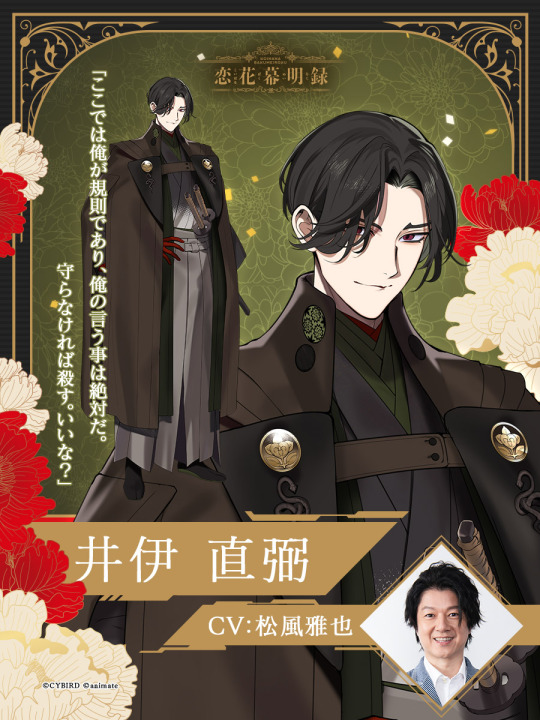
「ここでは俺が規則であり、俺の言う事は絶対だ。守らなければ殺す。いいな?」
"I am the law here and my word is absolute. If you don't do as I say, I'll kill you. Is that clear?"
Ii Naosuke
CV: Matsukaze Masaya
29 notes
·
View notes
Text
Seeing Ii Naosuke's name in my History class syllabus like

Very excited for this semester
5 notes
·
View notes
Text
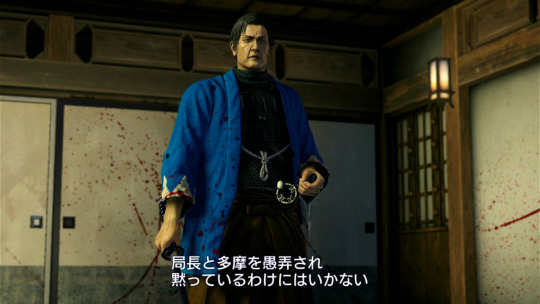
I wrote an endnote to one of my fics that ended up being so long and spoiler-heavy that I had to exile a big chunk of it to my tumblr - so here you go: a big ol' Effort Post about the history and fictional history of your guy and mine, Ishin Wagi.
If you haven't finished Ishin, you probably shouldn't click to read the post under the cut, as it contains big endgame spoilers.
In contrast with Inoue Genzaburo — who’s portrayed in Ishin and other media as a serious, level-headed sort of guy — Serizawa Kamo was a heavy drinker with an infamously short temper. He was born in Mito and, like Sakamoto Ryoma, he was a member of the goshi class, though it should be noted that the extreme discrimination that we see Ryoma experiencing in-game is pretty specific to Tosa’s goshi; Serizawa wasn’t particularly poorly off. Also like Ryoma, Serizawa was involved in shishi activities: he was a member of the Tengu Party, an anti-foreigner political group whose members committed various acts of violent rebellion, including the 1860 assassination of Ii Naosuke (a high-ranking official in the Tokugawa shogunate whose death comes up in letters that you can find in Ishin Kiwami). Serizawa didn’t participate in the assassination, but between his ties to the Tengu Party and an incident in which he executed several of his subordinates for no good reason, he ended up in prison, where he assumed he’d be executed in turn. While there, Serizawa was said to have written a poem with his own blood on a piece of scrap cloth: “In the snow and frost, the plum blossom is the first to bloom in brilliant colours; its fragrance lingers even after the petals have scattered.”
In late 1862, Serizawa was released from prison. By early 1863 (and here I’m skimming over a lot of historical context) Serizawa had joined up with Kondo Isami as a member of the Mibu Roshigumi: the precursor to the Shinsengumi, so called because they were a bunch of ronin whose headquarters were originally in Mibu. They worked under the patronage of the Aizu clan; one of Serizawa’s brothers may have had connections to the clan, which Serizawa and Kondo might have leveraged to gain support for their organization. As a commander, Serizawa was kind of a disgrace by most accounts: among other offenses, he was responsible for wrecking a restaurant in a drunken rage and destroying a silk merchant’s shop with a cannon. Most importantly for my purposes, he was allegedly the man who picked a fight with a bunch of sumo wrestlers in the streets of Osaka.*
Serizawa was murdered in 1863, and there are various theories as to why. It’s popularly assumed that the guy was just a huge bastard who was too out-of-control to hold down his job, and that Hijikata and several other members of the organization killed him accordingly. Another theory that you’ll see sometimes is that while his familial connections were useful, Serizawa himself was a liability whom his companions discarded as soon as they felt secure in doing so. Under this theory, the issue wasn’t so much that he was badly behaved (though this probably didn’t help); it was more that he had his own little faction of men who went around looking down on the others and calling Serizawa “sensei,” and that Serizawa had ties to Mito, which remained a hotbed of seditious activity. (In fact, in 1864, civil war would break out in Mito as the Tengu Party staged an armed rebellion against the shogunate.)
I understand why Ishin’s writers dropped most of Serizawa’s history. It’s complicated, it’s not directly relevant to Ryoma’s story, and Inoue is a secondary character who’s meant (like his mainline counterpart) to come across as a superlatively loyal mentor figure and not as a belligerent asshole. But it’s interesting, in that context, that the writers went out of their way to allude to Serizawa’s history in weird ways. In-game, Serizawa is described as “a living shadow from the Mito domain” — which, okay, you could indeed describe the historical Serizawa that way, given that he narrowly escaped execution and then left Mito to join the Roshigumi. But he’s also described as a wandering bandit who took Hirayama and Hirama under his wing before meeting Kondo in Kyoto, which doesn’t particularly fit with history. Okita — our Okita, the fake one, lol — also says that the three of them committed dappan and were promised a pardon by the Mito domain if Serizawa assassinated Yoshida Toyo, which also has no basis in historical reality but which does make him an accessory to the big players’ nasty schemes for a comprehensible reason. Finally, Serizawa’s school of swordsmanship is referred to as “Mito Tengu” despite the fact that, historically, Serizawa trained in the Shindo Munen school. Conveniently, Ishin’s writers managed to skip over Serizawa’s awfulness on a personal level and to avoid depicting the character in the game as a prominent (and very willing) member of a violently xenophobic political group. I’m listing all of these oddities not to make a judgement about the whitewashing of history, but because it's interesting to me that what did end up in the game is there at all: the writers didn’t need to, but they established a connection between Serizawa, the Tengu Party, and the shishi more broadly anyhow.
Of course, I have the brain disease that makes me latch onto minor characters for no good reason and will therefore take whatever little crumbs of Ishin Kashiwagi I can get. Still, typing all of this up made me think about the missed opportunities here. I would have loved to see the writers do more with some version of Serizawa who was a little less of a bastard but who still committed himself to the shishi’s cause in his Mito days and then grew disillusioned with that cause during his stay in prison and his time with the Mibu Roshigumi. It’s a neat point of sympathy between Inoue and Ryoma, who finds himself similarly chewed up and spat out by the Tosa Loyalist Party in the game. That connection lends gravity to Inoue’s decision to tattle on Ryoma to Kondo but also to keep covering for the guy every time he says or does something transparently suspicious. They might be, in a sense, kindred spirits.
It felt too tangential to delve too much into all of this stuff in my Ishin fics, but you can imagine this sense of sympathy lying behind Inoue’s actions throughout Chapter 4 of Secret History &c. (as well as in his little sequence in Chapter 2 of Glorious and Bloody Deeds &c.). You can also imagine that some of the big shishi conspirators in this story would have known about Serizawa’s origins in Mito with the Tengu Party — it was no big secret — and that they would have been appalled by his new allegiances but also suspicious that he had died because of his old ones. It’s also pretty reasonable to assume that the big Choshu players would have some sense of Saito’s identity, given that Hanpeita and Katsura are allies in Ishin’s version of events. Of course, I also think that our Ryoma wouldn’t know shit about any of this and would absolutely respond like, huhh? whaaaa??? to any/all allusions to the complicated politics behind all these stories. If you’re in a state of perpetual confusion about people and politics while playing Ishin, you’re just doing a great job of role-playing Bakumatsu Kiryu.
Anyway, nearly everything I write is turbo horny and my Ishin fics are no exception, so please don’t read them at work, but they’re very much about the stories men tell about themselves and others, and I think if all this stuff interests you, you might find the yarns I’ve spun interesting as well.
* This is another event that’s mentioned in passing in an in-game letter that was added to Ishin Kiwami, and whatever my feelings about that remake might be, I think all the letters and notes are a brilliant addition; I was tickled to see a reference to this incident show up! Historically, the Big Sumo Brawl happened well before 1867 and it had nothing to do with the events covered in Ishin, so please understand that when I’m writing about it in my fic, I’m mashing events together and playing around with a big Bakumatsu sandbox in a way that I think feels true to the game’s style of writing. I thought it would be funny to have Inoue lay claim to the act when he wasn’t even on the scene; it brings the story in line with history, but in the stupidest possible way. (Also, I submit to you that the smut is practically canon-compliant and likely historically accurate. :V)
#crime boys#yes I wrote an endnote to my endnote#surely you expect this of me by now#p.s. i am so incredibly tired of trying to find info on these guys and turning up nothing but posts about movies/tv/anime/gacha games#however i did get some interesting books from the library for my efforts so that's cool :>
26 notes
·
View notes
Note
What was the total number of tenchu assassinations in Kyoto and how frequent? Were there any tenchu or similar incidents like this outside of Kyoto?
I know you're not supposed to answer a question with a question, but just so we are on the same page, how do you define tenchu assassinations?
I want to define the term to mean assassinations carried out by the sonno joi movement, but some only use it to describe assassinations carried out after 1862, approximately around the time the imperial decree for the expulsion of foreigners was issued and the sonno-joi movement saw more widespread political support.
That said, I honestly don't think there is a clear answer to your first question, how many tenchu murders took place in Kyoto and how frequently they occurred.
I've poked around various books, journals, and websites in both English and Japanese, and a lot of material is really vague regarding numbers, even when it comes to tracking killings said to have been committed by the hitokiri, let alone by other, unnamed or lesser-known, assassins.
So I can't give you any idea about the overall number of such killings or how frequently they occurred, except to say they were obviously concerning enough in the Kyoto area in 1862 and 1863 that the need for restoring the safety of Kyoto was a pressing enough matter, which then also contributed to the formation of the Shinsengumi.
As for the second part, yes, there were many tenchu killings outside of Kyoto.
According to Tamura Yuichi, the first incidents of sonno joi-related murders occurred in 1859 and targeted foreigners: two Russians, and a Chinese man working for the French legation, and then in 1860 a translator for the British legation, two Dutch merchants, an Italian working for the French, and Hendrick (Henry) Heusken of the American consulate. Most of these were carried out by anonymous assassins.
The first real tenchu incident in the sense that the words heaven's punishment were used in connection to it, might be the Sakuradamon incident in Edo in 1860.
Here, 18 assassins (one from Satsuma and 17 from Mito) murdered Ii Naosuke, who was the chief minister to the shogun. They also killed a large number of samurai in his procession (and presumably some of the other attendants), but I don't think there's ever an actual number given.
In this case, the assassins' manifest reads in part: "Therefore, we have consecrated ourselves to be the instruments of Heaven to punish this wicked man, and we have taken on ourselves the duty of ending a serious evil, by killing this atrocious autocrat."
Ii's murder was also a turning point.
Prior to his murder, direct action against officials was almost exceedingly rare, while afterward, it became more commonplace.
However, if you consider 1862, the year in which the sonno-joi movement receives strong political backing, to be when tenchu murders start, then the first one would then be that of Shimada Sakon in July 1862.
Tamura tracks 46 documented murders between the second half of 1862 and 1863, which include several outside of Kyoto, such as the four yoriki incident in Ishibe-juku (about 40 kilometers from the center of Kyoto) and the murder of Ikeuchi Daigaku, who was killed on his way back from a banquet in Osaka.
One incident also worth mentioning is the Tenchugumi incident in Yamato province (now Nara prefecture), in which the group of ronin calling themselves the Tenchugumi occupied the magistrate's office in Gojo City (about 80 km from Kyoto) and beheaded the magistrate, putting his head on public display. Wiki Corpus has a page about it in English that you may find helpful and that saves me from typing up all of that info.
I hope this helps?
As always, if anyone has additional or better information, please add it! I'm doing my best, but I definitely don't know everything.
#history notes#historical notes#history reference#historical reference#history research#historical research#ask#answered ask#Japanese history#Bakumatsu period#tenchu murders
20 notes
·
View notes
Note
Assassination tier list request I forgot about until this second - killing of Ii Naosuke by imperial loyalist samurai in 1860
Oh man, they are a complicated one I think, its all tied up in the Sonno Joi/"Revere the Emperor, Expel the Barbarians" Movement and evaluating its goals and legacy.
So the context is that Li Naosuke was the Chief Minister of the Shogunate and the real leader - the shogun at the time was the 14-year old Tokugawa Iemochi that Naosuke had appointed in a power struggle that resulted in what is called the Ansei Purge, when over a 100 high daimyo (the fuedal clans of Japan under the shogunate) officials were arrested or killed for their opposition to Japan's opening up to the west and treaties with the foreign powers. Naosuke led this effort, which he had to - not like Japan had much of a choice in signing the treaties. He was trying to walk a line; appease the west while opening up Japan to strengthen the nation, and purging the government of anti-shogunate forces to keep the government strong enough to do that.
His assasination (the Sakurada-mon Incident) in 1860 was led by a band of samurai from the Mito daimiyo, one of the victims of the purge, and it was both part of and ushered in a wave of terrorism and civil violence in Japan that fatally undermined the shogunate and its relationships with the Imperial Court and the daimiyo lords. I think this is one of those *extremely* impactful acts of terrorism. Naosuke was striking a bargain with Japan's elite; you work with me, and we will weather this storm the west is inflicting on us, and if you don't I will destroy you. This was absolutely working at the elite levels, there were not large overt actions being conducted to undermine the Shogunate at the time and real reforms were being made. In return, the lower-ranking samurai, educated, priviledged, but relatively powerless, were furious at the level of appeasement, engaging in terrorism and violence. The violence wasn't getting elite buy-in though; the shogunate was the default for the ruling Daimiyo and they had been threatened into toeing the line.
There is a japanese term Gekokujō, "the low rules the high", which is very fitting here. Killing Naosuke opened the floodgates; not only did his death cause the shogunate to flail around rudderless for a long stretch, but it empowered the Sonno Joi samurai to run riot, not only attacking the government but also pressuring the daimiyo elite themselves into treason. Naive portrayals of Japan at the time pit "shogunate vs daimiyo" as the primary conflict, and its a conflict for sure, but just as important is the conflict between the elite vs the radicals. After Naosuke's death Gekokujo ruled, the elite feared the radicals *more* than they feared the shogunate. They began to work against the shogunate in order to appease the factions in their own court that now, embolded, might assasinate them if they didn't. And man were there assasinations in the Bakumatsu period - so many that attacks on westerners eventually inspired a military invasion of the Shimonoseki treaty port in 1864, which hugely weakened the shogunate. You can trace a direct line between those actions and the Sakurada-mon incident; it was the "propaganda of the deed" that showed every angry disempowered saumrai that they too could make a difference via extreme violence, while pushing daimyo over the edge into the anti-shogunate faction by breaking the spell the Ansei Purges cast.
(This does bring up the topic that due to technology of weapons & information + outdated legacy governing systems, the Long 19th Century was the ideal time for assasinations to make a difference. Thread for another time though)
So A+ or S easy, right? It set the stage for the collapse of the shogunate as much as one assasination could, right? Well, not so fast. We are lucky for this one - the assasins left a manifesto! We know excatly why they did it:
"While fully aware of the necessity for some change in policy since the coming of the Americans at Uraga, it is entirely against the interest of the country and a stain on the national honour to open up commercial relations with foreigners, to admit foreigners into the Castle, to conclude treaties with them, to abolish the established practice of trampling on the picture of Christ, to allow foreigners to build places of worship for the evil religion, and to allow the three Foreign Ministers to reside in the land ... Therefore, we have consecrated ourselves to be the instruments of Heaven to punish this wicked man, and we have taken on ourselves the duty of ending a serious evil, by killing this atrocious autocrat"
Peak Sonno Joi vibes, its all here - expel the foreigners, cut trade, purge the body-politic, RETVRN. To achieve this goal, they allied with the emperor, formed an anti-shogunate faction, overthrew the government, and ushered in the Meiji Restoration to return Japan to the old ways.
How did, uh, that work out?



...yeah. The Meiji Restoration is one of those things where the dissident samurai intellectuals blamed the shogunate for the entirety of Japan's problems, when virtually none of them were the shogunate’s inherent fault - the new government inherited all of those problems and no new solutions. But, with more centralized control and cooled tempers (and dead bodies) once the Boshin War let everyone scapegoat the shogunate, the new Meiji government proceeded to go ULTIMATE WESTERNIZATION and crash course into modernizing the country in a way the shogunate could only dream of.
Samurai? Gone. Feudalism? Gone. Western Clothes? Check. Parliament? Check. Christianity? Legally permitted in 1871, ushering in a boom of churches and schools. Hell they even switched over to the western time system in 1872, you wouldn't even know *when* to ~retvrn~ to at that point. These changes isolated so many of these former samurai they launched the Satsuma Rebellion in 1877, led by ur-samurai Saigo Takamori and possibly Tom Cruise (and who, by the way, absolutely used guns & artillery). They were crushed, and westernization continued. The new Japanese government did fight back to restore its soveriegnty in regards to the West at least, but not in the way the Sonno Joi samurai wanted.
On the near-term goal of destabilizing the shogunate and inspiring their dissident reactionary comrades, the Sakurada-mon Incident was a rousing success. On the far-term goal of its actual political agenda, it empowered a faction that betrayed its agenda on every level. They achieved nothing they truly wanted but the deaths.
Still, as harsh as that all sounds, you can't go *that* far into history, this is a long stretch of time. From the vantage point of 1860 few in Japan knew how irreversible modernity was going to be. The Meiji government certainly didn't - they did not at all set out to End Feudalism, instead finding they simply had no choice if they wanted to compete. The assasins were definitely in the foolish side of the conflict, real leaders knew something had to change, but its too much to put the Meiji Restoration on the shoulders of this one act. They did change Japan in a way that pursued their goals, even if they turned out to be impossible, and things like the immortalization of the emperor in the new Meiji system have to count for some reactionary points.
So for their impact, the inspiration they provided to countless violent samurai reactionaries, and the inherent uncontrollability of Japan's modernization, I will give them an A-/B+, right on the threshold. Definitely a complicated case.
Also this whole exercise as really highlighted Japan's long, deep history of effective terrorism, if we did a country/terrorism ranking they might be near the top.
124 notes
·
View notes
Text
Koihana Bakumeiroku Gacha 5★ Card CGs








All photos ©CYBIRD ©animate
I do not own any of the Koihana Bakumeiroku content being uploaded on this blog, everything belongs to CYBIRD and Animate. Please support them by playing the game and buying stories.
These 5★ cards can be obtained from the premium card gacha that will be available in-game!
Character Names (In Order):
Saito Hajime ; Kido Takayoshi
Enomoto Takeaki ; Katsu Kaishu ; Hijikata Toshizo
Ii Naosuke ; Saigo Takamori ; Kirino Toshiaki
45 notes
·
View notes
Text
Now that it’s not the middle of the night, I can properly look at Ikevil and Koibaku’s collab cafe menu items
Harrison - Strawberry milk (true or false?) with a mint leaf and monaka wafers in the shape of fox ears
Liam - Rosehip tea and gummy paws
Alfons - Soda with cotton candy and blue curaçao syrup you pour over and watch the cotton candy dissolve so good luck trying to take pics of your drink
Roger - Apple juice in the style of beer, dried peas snack, monaka wafer in the shape of glasses
Ellis - Grape juice with orange jelly and mixed berries
Victor - (cursed) coffee with rose-shaped sugar cubes. Drink and you will become a part of Crown
Enomoto Takeaki - Tieguanyin tea and bean snacks
Hijikata Toshizou - Acerola juice with plum syrup and mint
Ii Naosuke - Genmaicha with red bean monaka
Milk tea with a random suitor’s emblem
William - Hamburger steak with fresh blood (Demi-glace and red wine sauce)
Jude - Nuggets and fries that Jude’s not going to eat so you eat it instead
Saito Hajime - Breakfast of grilled mackerel, rice, miso soup, lotus root
Kido Takayoshi - Omurice with a Japanese-style savory sauce, bamboo shoots, and peas
Kirino Toshiaki- Sweet potato curry
Elbert - Deep sea jewelry box dessert that’s blue jelly, Bavarian cream (or yogurt bavarois?), crushed biscuits, white chocolate, edible pearls, and a dried orange
Katsu Kaishuu - Matcha ice cream parfait with mochi, candied chestnut, red beans and a cherry
Saigou Takamori - Dorayaki, dango, vanilla ice cream with Japanese black sugar syrup
20 notes
·
View notes
Text
Oh yes, for another info
Cybird also have a new game in collaboration with Animate 🎉
Koihana Bakumeiroku

I must say, an modern version of Ikemen Bakumeiroku/Destined to Love 😂
About Story
The time setting in this story is at the end of the Boshin war and the beginning of the Meiji era
The MC who lost her childhood memories in certain incident, visited the new capital, Tokyo, after her adoptive parents passed away. Just when you were fascinated by the gorgeous cityscape, you were involved in an accident - a man suddenly appeared, giving you no choice but to pull out your memento sword
The man is Hajime Saito, he was once the captain of the Shinsengumi's 3rd division of the rebels and is now the captain of the Meiji government Battou corps. You will meet another characters and learned the existence of "Shikabito", a force that threatens the Meiji government
While chasing the incident surrounding the Shikabito, the new Tokugawa shogunate army led by Naosuke Ii, who lost his life in the past, appears. Beside him is Toshizo Hijikata, the vice commander of the Shinsengumi.
In short, you're caught up in a three-way battle ...
You risk your life to fall in love with him in the blazing fires of war
Character info is coming next!
22 notes
·
View notes
Text
What we know about Koihana Bakumeiroku

+ONE Label
It is a new game developed under the +ONE by Ikemen Series label. The +ONE (Plus One) label is a derivative/secondary label of the Ikemen Series, and the main concept of the label is that Cybird will partner will various other companies to combine their expertise in developing romance games aimed at women. Bakumeiroku is the first part of this series, and Cybird is collaborating with Animate for this game.

Characters, VAs, & Other Staff
Character design by Shirano (Twitter, Tumblr)
The characters are historical figures from the Bakumatsu era, with some being members of the Shinsengumi or other prominent figures from the era.
Unsure if there is any relation to Destined to Love/Ikemen Bakumatsu, Cybird's own (discontinued) game about the Bakumatsu era, sharing some of the same characters.
Cast list:
Saito Hajime (voiced by Nakamura Shugo)
Hijikata Toshizo (voiced by Furukawa Makoto)
Kido Takayoshi (voiced by Suzuki Ryota)
Ii Naosuke (voiced by Matsukaze Masaya)
Saigo Takamori (voiced by Kimura Ryohei)
Kaishu Katsu (voiced by Azakami Yohei)
Enomoto Takeaki (voiced by Okisu Kazuyuki)
Kirino Toshiaki (voiced by Sakata Shogo)
Official Info
The official website (this is also the website of the +ONE label but it does not appear to have anything else on it aside from Bakumeiroku)
Official twitter account
Further information will be announced at Animate Girls Festival this year, on November 5 (17:30 - 18:10 JST). Three of the seiyuu will be involved in the announcement: Nakamura Shugo, Suzuki Ryota, and Kimura Ryohei
25 notes
·
View notes
Text

Koihana Bakumeiroku : CYBIRD x Animate co-production
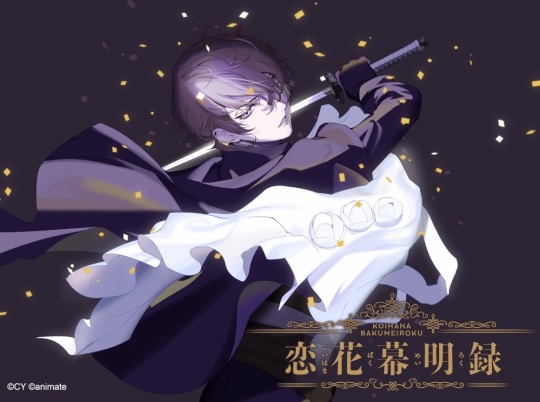
"Even if this life pass away... I'll surely walk with you again, because you are my destiny"
Game: Koihana Bakumeiroku (恋花幕明録)
By: Cybird, animate
Platforms: iOS, Android, animate Games (Browser)
Language: Japanese
Webstie: https://p-one.site/bakumeiroku
Twitter: https://twitter.com/bakumeiroku
Character design: Shirano (https://twitter.com/shirano_info)
"แม้ชีวิตนี้จะดับสูญ ฉันจะกลับมาอยู่เคียงข้างเธออย่างแน่นอน เพราะเธอคือพรหมลิขิตของฉัน"
+ONE by Ikémen Series : Koihana Bakumeiroku (Game Project)
🌸 Story set in the Meiji era after the Boshin War,
A turbulent love story with historical samurai such as Saito Hajime, Kido Takayoshi, and Hijikata Toshizo
🌸CAST
Saito Hajime CV: Nakamura Shugo #仲村宗悟
Hijikata Toshizo CV: Furukawa Makoto #古川慎
Kido Takayoshi CV: Suzuki Ryota #鈴木崚汰
Ii Naosuke CV: Matsukaze Masaya #松風雅也
Saigo Takamori CV: Kimura Ryohei #木村良平
Kaishu Katsu CV: Azakami Yohei #阿座上洋平
Enomoto Takeaki CV: Okisu Kazuyuki #興津和幸
Kirino Toshiaki CV: Sakata Shogo #坂田将吾
โอโตเมะเกมจีบหนุ่มโปรเจกต์ใหม่ล่าสุดจาก Cybird และ animate
ในยุคซามูไรของญี่ปุ่น
30 notes
·
View notes
Text

Daddy spotted!!!!
Naosuke Ii....
15 notes
·
View notes
Text
Koihana Bakumeiroku
Suitor Profiles, Lite Ver.
(All 8 Suitors)
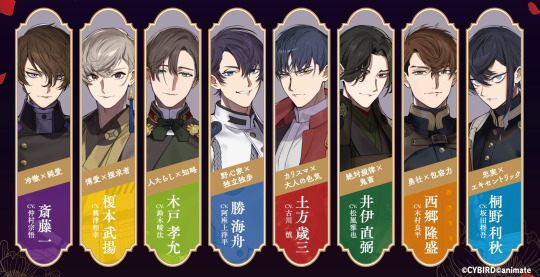
↳ Taken from the official site x
↳ I've included links to the wiki pages of the real-life people they're based on (in case you're as oblivious as I am)
↳ Translations may not be completely accurate, and may be totally off in some places
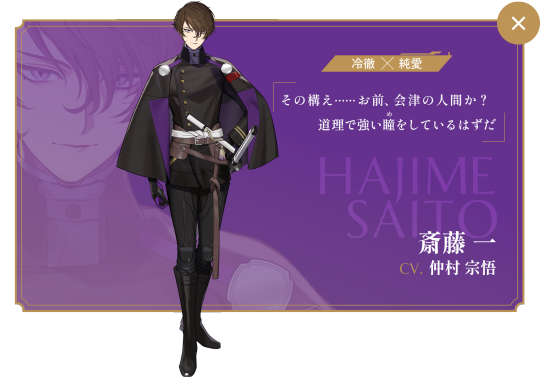
HAJIME SAITO (CV. Shugo Nakamura)
冷徹 ⨉ 純愛
Level-Headed ⨉ Pure Love
"That sword-stance... Are you from Aizu? No wonder you've got such strong eyes."

TAKAYOSHI KIDO (CV. Ryouta Suzuki)
人たらし ⨉ 知略
Smooth-Talker ⨉ Ingenuity
"'Kogoro the Runaway' you say? Why, I take that as a compliment. You can't do a thing if you're dead, after all."
*Kogoro was Takayoshi's birthname. "Kogoro the Runaway" is supposedly a nickname the IRL Takayoshi received for his knack for escaping in pinch (using disguises, deceit, etc.), though apparently this hasn't been historically verified? You may be familiar with his story from other media/games. (dubious(?) sources 1 2 3)

TAKAMORI SAIGO (CV. Ryouhei Kimura)
勇壮 ⨉ 包容力
Heroic ⨉ Broad-Mindedness
"I've got too many precious things on my hands. And that's why I don't have a second to waste."

TOSHIZO HIJIKATA (CV. Makoto Furukawa)
カリスマ ⨉ 大人色気
Charisma ⨉ Adult Sex-Appeal
"In the end, the only thing we can do is follow the path we believe in. That goes for me―and that goes for you."
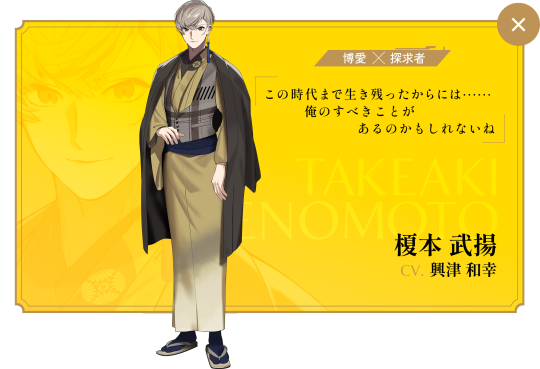
TAKEAKI ENOMOTO (CV. Kazuyuki Okitsu)
博愛 ⨉ 探求者
Philanthropy ⨉ Seeker
"Now that I've survived to this era... perhaps there's something for me to be doing."
*博愛 has a swathe of meanings that generally align with things like fraternity, charity, love of humanity etc.
*seeker in the sense that he is searching for something. Perhaps a purpose?

KAISHU KATSU (CV. Youhei Azakami)
野心家 ⨉ 独立独歩
Ambitious ⨉ Self-Reliant
"We may share a common front, but I don't trust you. Well, the feeling's mutual, isn't it?"
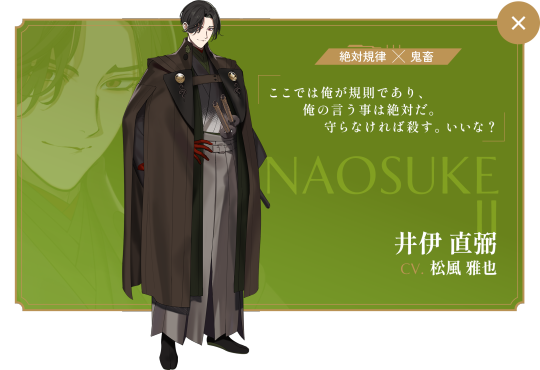
NAOSUKE II (CV. Masaya Matsukaze)
絶対規律 ⨉ 鬼畜
Absolute Discipline ⨉ Demonic
"I am the law here and my word is absolute. If you don't obey, I'll kill you. Is that clear?"

TOSHIAKI KIRINO (CV. Shogo Sakata)
忠実 ⨉ エキセントリック
Loyal ⨉ Eccentric
"You're a surprisingly good person, aren't you! Let's do our best for Saigo-san together!"

Meiji Government: Hajime, Takayoshi, Kaishu and Enomoto
New Tokugawa Shogunate: Naosuke and Hijikata
???: Saigo and Kirino
#koihana bakumeiroku#koibaku#ngl i'm daunted by how to tag these guys#except naodaddy is naodaddy#naodaddy
41 notes
·
View notes
Photo
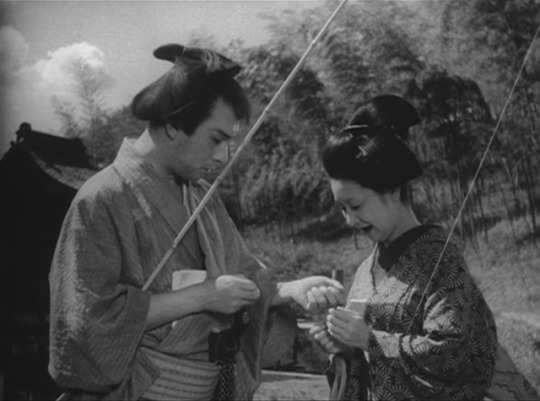
Ken Uehara and Kinuyo Tanaka in Yotsuya Kaidan (Keisuke Kinoshita, 1949)
Cast: Kinuyo Tanaka, Ken Uehara, Osamu Takizawa, Keiji Sada, Hisako Yamane, Jukichi Uno, Aizo Tamashima, Choko Iida. Screenplay: Eijiro Hisaita, Masaki Kobayashi, based on a play by Nanboku Tsuruya. Cinematography: Hiroshi Kusuda. Production design: Isamu Motoki.
Yotsuya Kaidan is one of the most famous Japanese ghost stories, put in classic form in the kabuki drama written by Nanboku Tsuruya in 1825. But in adapting the tale of a ronin, a masterless samurai, pursued by the vengeful phantom of the wife he murdered, Keisuke Kinoshita and his screenwriters, Eijiro Hisaita and the uncredited Masaki Kobayashi, jettisoned the supernatural elements to turn it into a psychological drama with overtones of Shakespeare tragedy: the ambition of Macbeth and the jealousy of Othello, abetted by an Iago-like villain. The ronin of Kinoshita's film, Iemon Tamiya (Ken Uehara), was dismissed by his former master for failing to guard the storehouse from a thief; he now ekes out a living with his wife, Oiwa (Kinuyo Tanaka), making and selling umbrellas. But while drowning his sorrows in sake one evening, he is approached by Naosuke (Osamu Takizawa), who plants in him the idea of wooing the wealthy Oume (Hisako Yamane), whose father has the connections that would enable him to find a master and restore his status as a samurai. Naosuke also plots with Kohei (Keiji Sada), with whom he served some jail time, to woo Oiwa, with whom Kohei has been infatuated since the days when she worked in a teahouse. Kohei's attentions to Oiwa arouse Iemon's jealousy, which Naosuke plays upon. As the prospect of marrying Oume becomes more likely, Iemon is given a poison to use on Oiwa, but he's initially reluctant to go that far. When Oiwa accidentally scalds her face, producing a horrible disfigurement, Naosuke provides an "ointment" that puts her in terrible pain and Iemon administers the poison. In the turmoil that follows Oiwa's death, Naosuke also kills Kohei. Freed to marry Oume, Iemon finds himself tormented by a guilty conscience, and when he learns that Naosuke was the one who robbed the storehouse that led to Iemon's dismissal by his former master, he turns on the conspirator. A fiery conclusion results. Kinoshita released the film in two parts, the first running for 85 minutes, the second for 73 minutes. Part I is more tightly controlled, efficiently introducing its characters -- there are lots of secondary ones, including Oiwa's sister, Osode (also played by Tanaka), and her husband, Yomoshichi (Jukichi Uno), who provide a kind of grounding in normal life. Kinoshita is not as successful at marshaling all of the secondary plots in Part II, and I tend to blame the director's tendency to sentimentalize, including the search of Kohei's mother for her son, for the weaknesses in the later parts of the film. But he gives his characters depth -- there is more sympathy for Iemon in the film than in more traditional versions of the story, which has been filmed many times.
2 notes
·
View notes
Text
13日01月2023年, 金曜日
It is so late already! How did this happen?
Grammar
Noun + による - by means of; due to; owing to; because of.
井伊の赤鬼こと井伊直弼による【安政の大獄】が始まり、両者共に処罰対象とされたのです。
Because Ansei purge was started by Ii Naosuke, also known as Red Oni of Ii, they both were subjected to punishment.
New words
大体, だいたい - generally, almost
普段[ふだん] 大体[だいたい]どこに 遊[あそ]びに 行[い]くの? Where do you usually go to play?
Anki
Repeated my deck and added new words, see above.
Reading
西郷と共に入水自殺した月照~京都清水寺の住職はなぜ自死を選んだ?
[REDACTED]
Listening
None!
Resources
西郷と共に入水自殺した月照~京都清水寺の住職はなぜ自死を選んだ?
[REDACTED]
1 note
·
View note
Note
every time i see your banner i think it's mice at first and it takes a rather jarring moment to figure out it is in fact not that
Mice? Haha, def not😆 It's the assassination of Ii Naosuke, a scene from a Japanese drama I watched ages ago.
0 notes
Text
Koihana Bakumeiroku

These are fan-made translations solely for entertainment purposes with no guaranteed perfection. I do not own any of the original content. Please support CYBIRD by buying their stories and playing their games. Reblogs appreciated.
Please be informed that I am no longer translating for this game, as I have way too much on my plate. Existing translations will not be deleted.
Official YouTube ┊Official Twitter ┊Official Website
Announcement PV
Story Synopsis
Character Profiles
Saito Hajime┊Kido Takayoshi┊Saigo Takamori
Enomoto Takeaki┊Katsu Kaishu┊Hijikata Toshizo
Ii Naosuke┊Kirino Toshiaki
Character Short PV
Saito Hajime┊Enomoto Takeaki┊Kido Takayoshi
Katsu Kaishu┊Hijikata Toshizo┊Ii Naosuke
Saigo Takamori┊Kirino Toshiaki
Prologue
Chapter 1┊Chapter 2┊Chapter 3┊Chapter 4┊Chapter 5
Chapter 6┊Chapter 7┊Chapter 8┊Chapter 9┊Chapter 10
Main Story
Story Synopses
Saito Hajime┊Kido Takayoshi┊Hijikata Toshizo
Story Previews
Saito Hajime┊Kido Takayoshi┊Hijikata Toshizo
Event Stories┊Miscellaneous Content
Bond Stories
Katsu Kaishu
35 notes
·
View notes